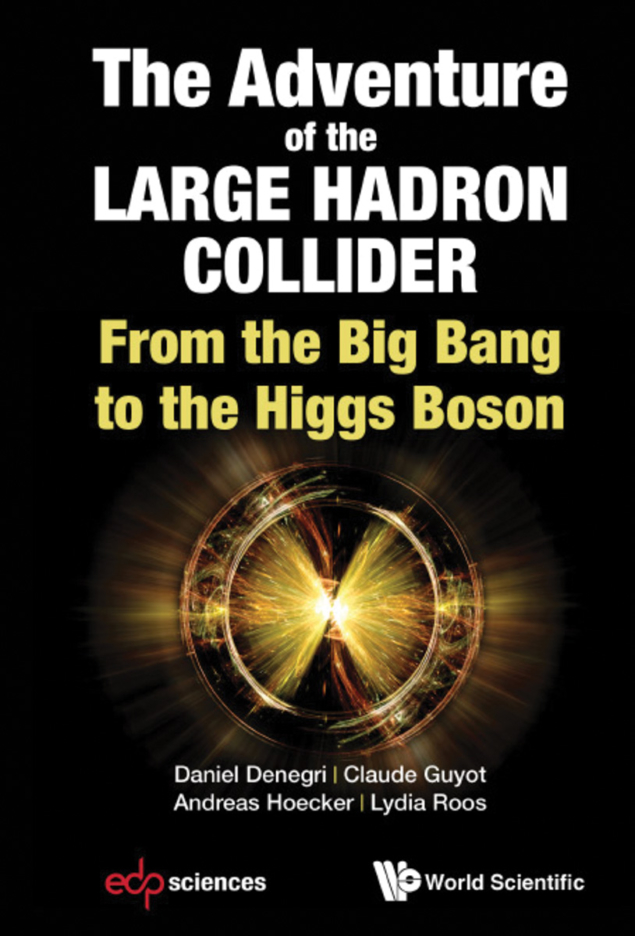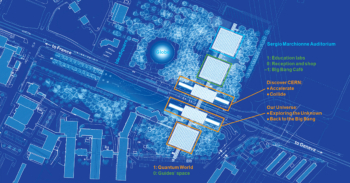The Adventure of the Large Hadron Collider: From the Big Bang to the Higgs Boson, by Daniel Denegri, Claude Guyot, Andreas Hoecker and Lydia Roos, World Scientific

With this ambitious book, the authors have produced a unique and excellent account of particle physics that goes way beyond a description of the LHC project. Its 600 pages are a very pleasant, although tough in places, read. The book serves as a highly valuable refresher of modern concepts of particle physics, recalling theoretical ideas as well as explaining advanced detector technologies and analysis methods that set the stage for the LHC experiments and the Higgs-boson discovery. Even though the focus converges on the Higgs boson, the full LHC project and its rich physics playground are well covered, and furthermore embedded in the broader context of particle physics and cosmology, as the subtitle indicates.
In a way, it is a multi-layered book, which makes it appealing for the selective reader. Each layer is in itself of great value and highly recommendable. The overarching presentation is attractive, with great photos, nicely prepared graphics and diagrams, and a clear structure guiding readers through the many chapters. Quite unique are the more than 50 inserted text boxes, typically one to three pages long, which explain in a concise way the concepts used in the main text. Experts may wish to skip some of them, but they are very educational (at least as a refresher) for most readers, as they were for me. The text boxes are ideal for students and science enthusiasts of all ages, although some are more demanding than others.
To start, the authors take the reader off into a substantial 170-page introduction to particle physics in general, and to the Standard Model (SM) in particular. Its theoretical ideas and their mathematical formulations, as well as its key experimental foundation, are clearly presented. The authors also explore with a broad view what the SM cannot explain. Some material in these introductory chapters are the most demanding parts of the book. The theoretical text boxes are a good opportunity for physics students to recall previously-acquired mathematical notions, but they are clearly not meant for non-experts, who can readily skip them and concentrate more on the very nicely documented historical accounts. A short and accessible chapter “Back to the Big Bang” concludes the introductions by embedding particle physics into the broader picture of cosmology.

Next, the LHC and the ATLAS and CMS experiments enter the stage. The LHC project and its history is introduced with a brief reminder of previous hadron colliders (ISR, Spp–S and Tevatron). The presentation of the two general-purpose detectors comes with a short refresher on particle detection and collider experiments. Salient technical features, and collaboration aspects including some historical anecdotes, are covered for ATLAS and CMS. The book continues with the start-up of the machine, including the scary episode of the September 2008 incident, followed by the breathtaking LHC performance after the restart in November 2009 with Runs 1 and 2, until Long Shutdown 2, which began in 2019.
The story of the Higgs-boson discovery is set within a comprehensive framework of the basics of modern analysis tools and methods, a chapter again of special value for students. Ten years later, it is a pleasure to read from insiders how the discovery unfolded, illustrated with plenty of original physics plots and photographs conveying the excitement of the 4 July 2012 announcement. A detailed description of the rich physics harvest testing the Higgs sector as well as challenging the SM in general provides an up-to-date collection of results from the LHC’s first 10 years of physics operations.
A significant chapter “Quest for new physics” follows, giving the reader a good impression of the many searches hunting for physics beyond the SM. Their relations to, and motivations from, theoretical speculations and astroparticle-physics experiments are explained in an accessible and attractive way.
A book about the LHC wouldn’t be complete without an excursion to the physics and detectors of flavour and hot and dense matter. With the dedicated experiments LHCb and ALICE, respectively, the LHC has opened exciting new frontiers for both fields. The authors cover these well in a lean chapter introducing the physics and commenting on the highlights so far.
A look ahead and conclusion round off this impressive document about the LHC’s main mission, the search for the Higgs boson. Much more SM physics has since been extracted, as is amply documented. However, as the last chapter indicates, the journey to find directions to new physics beyond the SM must go on, first with the high-luminosity upgrades of the LHC and its experiments, and then preparing for future colliders reaching either much higher precision on the Higgs-boson properties or higher energies for exploring higher mass particles. Current ideas for such projects that could follow the LHC are briefly introduced.
The authors are not science historians, but central actors as experimental physicists fully immersed in the LHC adventure. They deliver lively first-hand and personal accounts, all while carefully respecting the historical facts. Furthermore, the book is preceded by a bonus track: the reader can enjoy an inspiring and substantial foreword by Carlo Rubbia, founding father and tireless promoter for the LHC project in the 1980s and early 1990s.
I can only enthusiastically recommend this book, which expands significantly on the French version published in 2014, to all interested in the adventure of the LHC.





